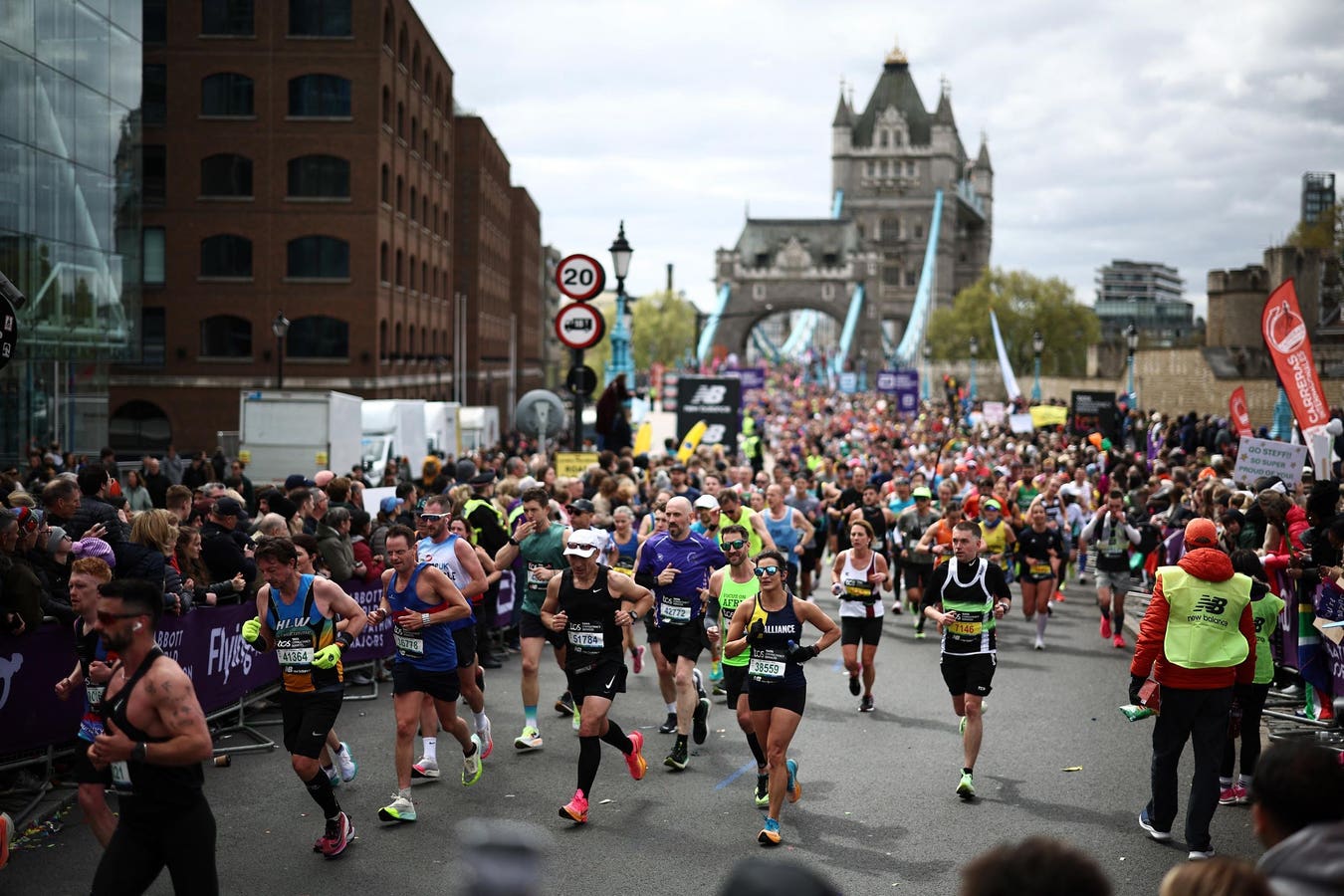Fun runners cross Tower Bridge during the 2024 London Marathon in central London on April 21, 2024. … More
As over 56,000 runners lace up for the 2025 TCS London Marathon, many will have relied on technology through their training journey. A booming wearables market is forecast to be worth $171 billion by 2032, and GPS watches, mobile apps and AI-powered platforms collect data that enables runners to optimise performance.
Organisers of the London Marathon are also relying on innovative technology, not just to deliver a seamless event but to reduce its environmental impact. From smarter, waste-reducing logistics, turning runners’ urine into fertiliser and carbon removal investments, organisers are leveraging tech for impact.
In a world where sports tourism is booming, and its carbon footprint rising, London Marathon’s sustainability initiatives offer insights of how large events can balance performance with responsibility.
1. Circular Technology Creates Fertiliser From Urine
A start-up that recovers nutrients from human urine to create bio-based fertiliser will be putting the pre-race toilet stop to good use this year. Around 1,000 litres of urine will be collected and made into fertiliser, to be used in tests to assess its performance on wheat growth. In a conversion process similar to treating waste water, bacteria will be added to create ammonium nitrate, that plants need to grow.
Fun runners cross Tower Bridge during the 2024 London Marathon in central London on April 21, 2024. … More
Hannah Van Den Bergh, founder of NPK Recovery, the organisation responsible for the novel manufacturing technology, shared, “Urine doesn’t have to be a waste product and we’re excited to be playing a small part in helping support the sustainability commitments of the iconic TCS London Marathon.”
The urine is collected in innovative gender equalising women’s urinals, that are three times quicker to use than regular portable toilets. Amber Probyn, co-founder of PEEQUAL, said, “We love coming to the TCS London Marathon because we firmly believe that women shouldn’t have to choose between starting their race on-time or waiting to go to the loo.”
Kate Chapman, head of sustainability for London Marathon Events commented, “part of our environmental strategy is to try and find an ‘onward use’ for all waste that is generated at our events, for instance composting, reusing, upcycling and much more besides.”
2. App Measures and Reports Impact
A cloud-based app for responsible event planning enables London Marathon Events to track, measure, and report the marathon’s environmental and social impacts in real time. It helps organisers audit carbon savings, identify areas for improvement, and transparently communicate their progress toward net zero by 2030.
LONDON, ENGLAND – APRIL 21: Runners cross Tower Bridge during the 2024 TCS London Marathon at on … More
Transparent and verifiable impact reporting helped LME recently become the first sports organisation to achieve “evergreen” status from the Council for Responsible Sport, recognising its leadership in creating positive social and environmental change.
Michelle Sandquist, certification director shared, “London Marathon Events has set a new global benchmark for what it means to lead with purpose. Their work exemplifies what’s possible when innovation, accountability, and community are at the core of event planning.”
3. Carbon Removal To Tackle Travel Emissions
Over 56,000 people will travel from all over the world to take part in the 2025 TCS London Marathon, which creates a lot of carbon emissions. To compensate, organisers charge international participants a £26 ($34) climate levy at registration, that is used for carbon removal. Technology-based solutions such as direct air capture, biochar, and enhanced weathering are among the verified carbon removal methods supported.
A fun runner wearing a fire enginer costume competes during the 2024 London Marathon in central … More
“This initiative is valuable because it not only reduces emissions but also raises awareness,” chief financial officer of LME, Jeanette Wong explained recently. “Encouraging people to think about their travel choices is an important step in shifting behaviour.”
In LME’s most recent published sustainability report from 2023, scope 3 green house gas emissions, which are those caused by participant travel, supply chain activity and the lifecycle of products purchased, accounted for over 99% of the marathon’s carbon footprint.
4. Event Management Software Cuts Waste
Waste creation is a huge contributor to the environmental footprint of sports events. To tackle this, the London Marathon uses smart registration technology that asks runners key questions to help reduce waste. Participants are asked if they would like to receive a finisher’s medal, allowing organisers to produce only what is needed and cut down on excess manufacturing and shipping emissions. Runners are also given the option to plant a tree instead of receiving a finisher’s t-shirt, helping to reduce the environmental impact of textile production while supporting reforestation efforts.
Russ Cook, who has run across the African continent from South Africa’s Cape Agulhas to Tunisia’s … More
For those who opt out of receiving a medal, some are available to loan at the finish line, to take photos and capture the moment. Medals are made from recycled zinc alloy, and ordered in bulk to reduce travel emissions, leftover medals and ribbons are recycled within the U.K.
Smart logistics is at the heart of new baggage-free assembly area. Team Green runners who either avoid bringing a kit bag or drop it off the day before the race help reduce the need for baggage trucks. This cuts fuel emissions and improves logistics efficiency on marathon day.
The TCS London Marathon’s 2025 sustainability efforts shows that bold ideas and technology can help the world’s biggest races tread more lightly. From converting waste into resources to removing carbon from the atmosphere, every initiative reflects a deeper shift in mindset, one that prioritises innovation, accountability, and long-term impact. As global sports tourism continues to grow, the London Marathon sets a powerful example, the future of major events lies not just in performance and spectacle, but in how responsibly they are delivered.








